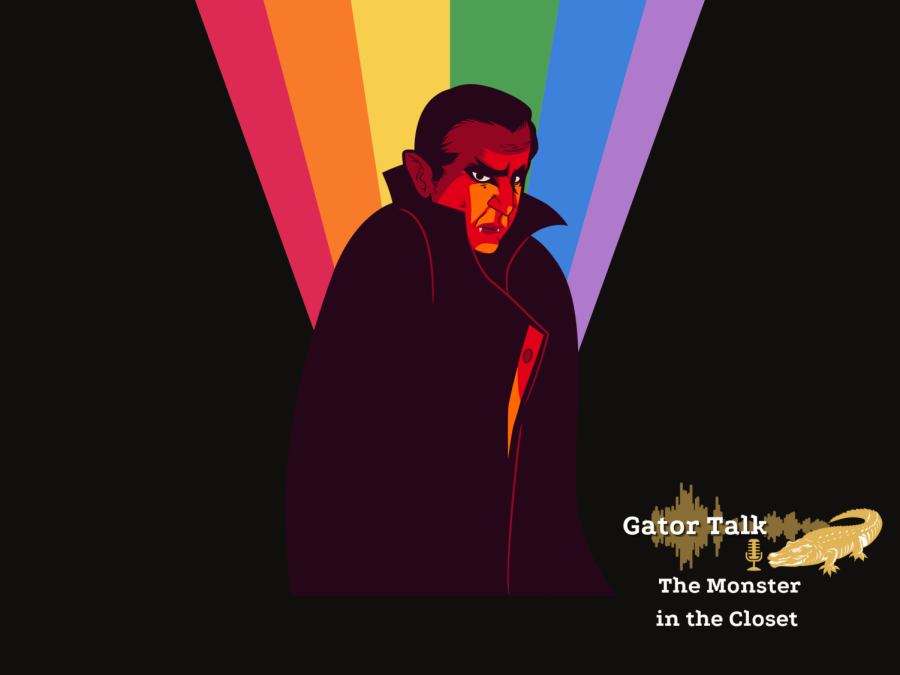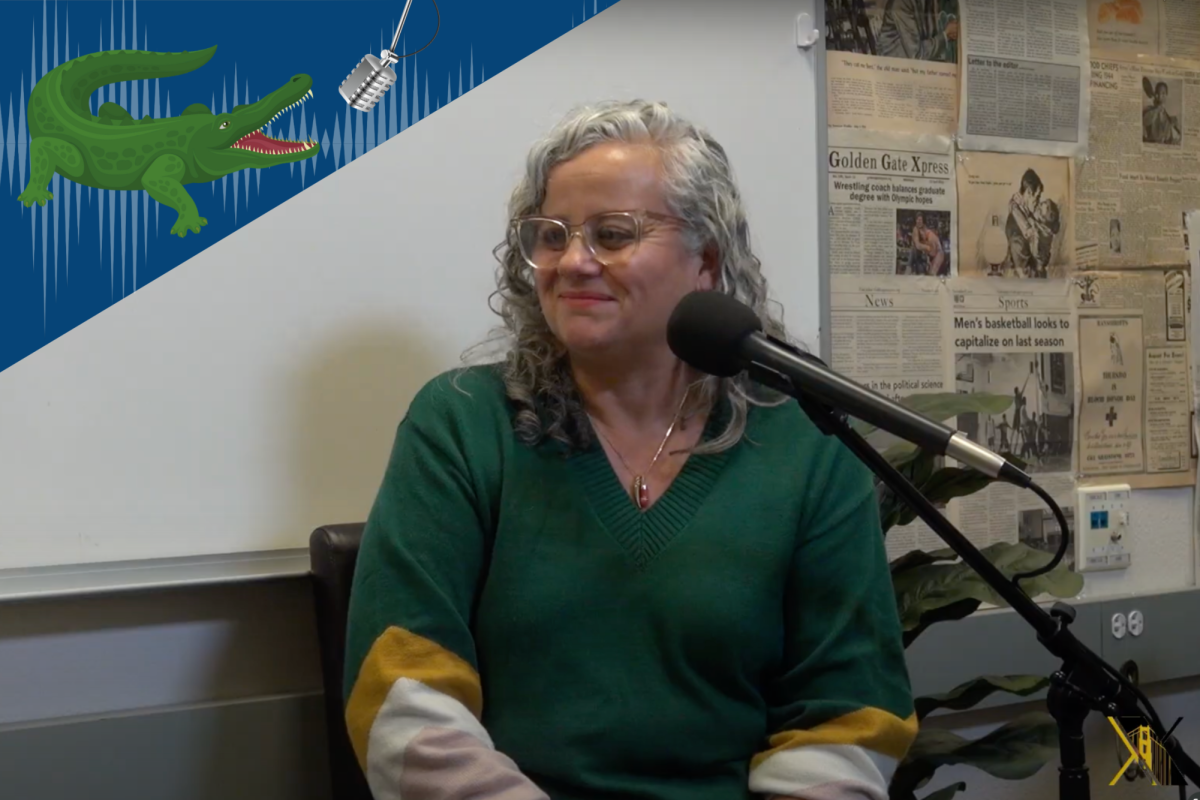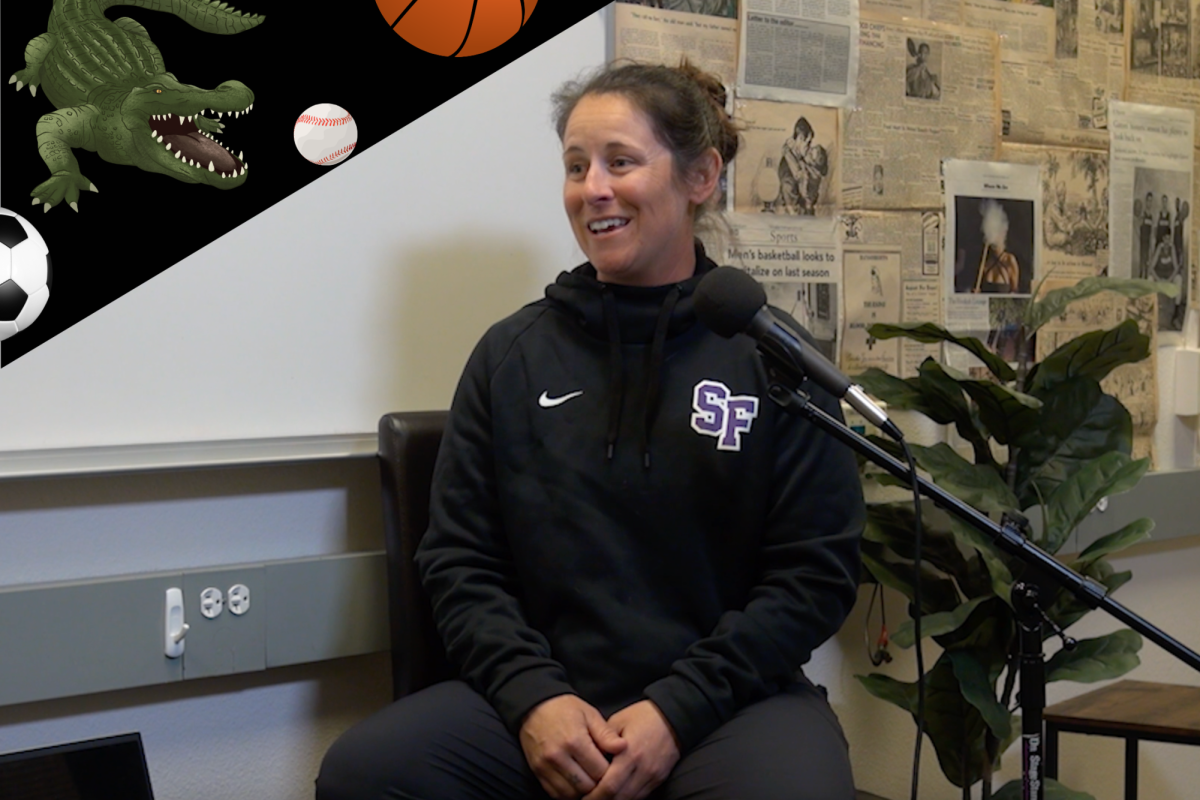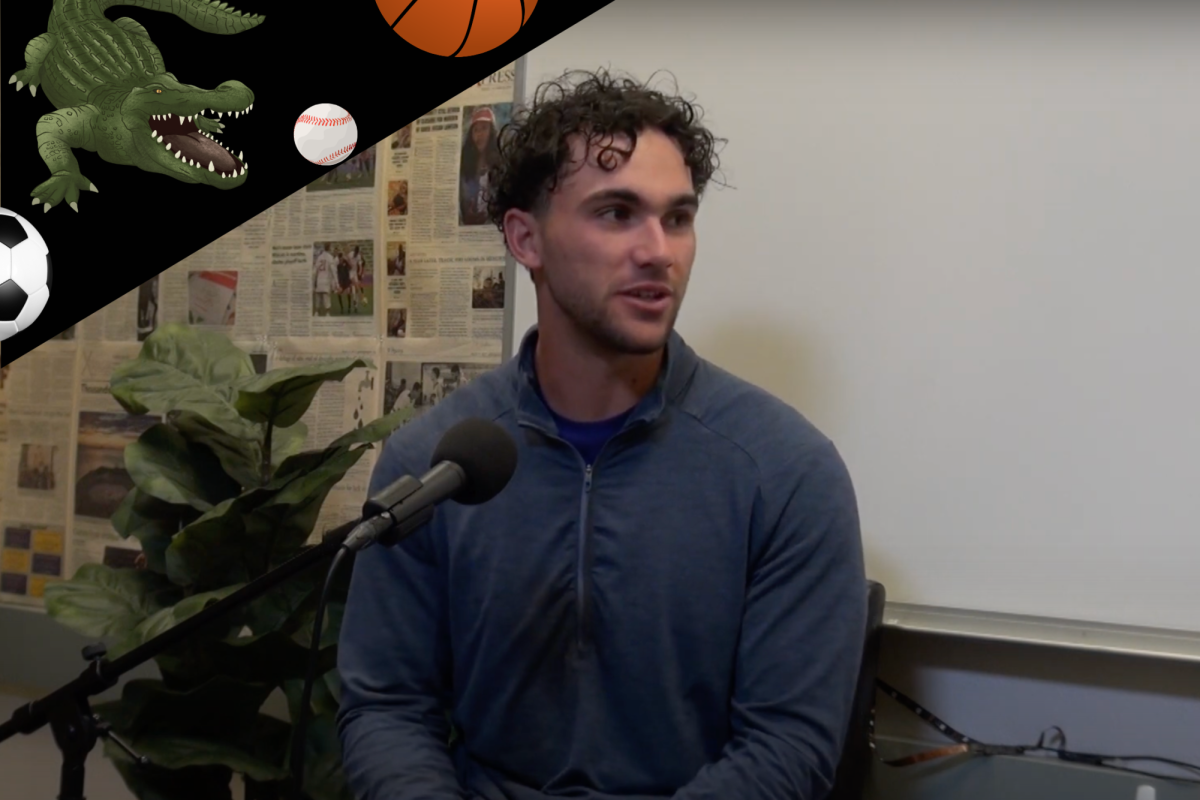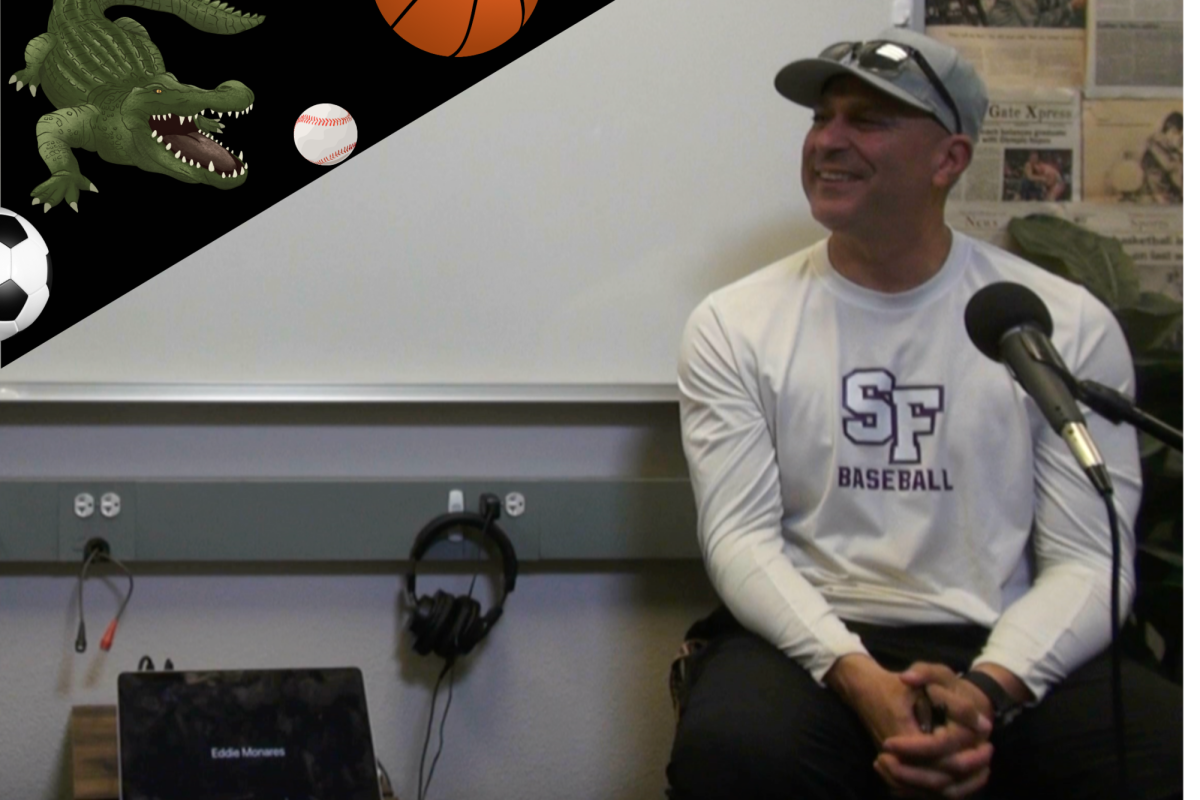Welcome to Gator Talk, a collaborative CalState podcast that brings city and statewide perspectives to SF State news. This week, Xpress’ City News Editor takes over the episode for a Halloween special.
This special Gator Talk episode serves as a love letter to the genre as the audience will hear cinephiles break down the impact Hays Codes had on horror movies. You’ll later hear an explanation in the evolution of horror from myth to literature and how the origins of these archetypes would later be interpreted as queer.
TRANSCRIPT:
Bonus episode preview
Hey ya’ll, it’s Seb here. Your Visuals Editor and host of Gator Talk and Chiva Pod.
We’re about to approach Week 11 in the semester. So I just wanted to take the moment to thank y’all for listening. Without you y’all, we wouldn’t be working throughout the week to make an amazing episode for the audience. Thank you!
I just have a couple of things I want to mention.
1. We at Golden Gate Xpress have a special episode for Halloween, this episode will air Sunday morning. Stay tuned…if you dare!
2. I hope you’re enjoying listening to Chris Ramirez, our EIC and Co-host of Gator Talk. He will be picking up the reins as a Host next semester because I’ll be graduating!
3. I don’t mention it here at all on the podcast but I also am an intern at KQED’s Bay Curious podcast. A show that centers around answering audience’s questions they might have about the Bay Area. I’ve been asked to extend my internship to June 30, 2022. That’s huge! If you miss hearing the stories I work on, catch me @ Bay Curious!
That’s enough for me!
I’m signing off.
Intro
Seb: Hey hey, it’s Seb. I’m your Visuals Editor and your host of Gator Talk.
(normal voice shifts to sinister voice)
We at Golden Gate Xpress wanted to wish y’all a Happy Halloween, Gators.
Here’s a quick preview of the show.
Preview
Seb: So we have a special episode for y’all today.
City News editor Anaïs-Ophelia Lino will take over the episode. Starting now.
*Thunder claps*
*Theme song ends.*
*Crackle of a fireplace starts*
Main Story
Anaïs: Happy Spooktober, Gators! City editor Anaïs-Ophelia Lino calls to you from beyond…
*records scratch*
Anais: Midterms that is! I hope you’re hanging in there. We’re here for a very special episode of Gator Talk, sit back and relax.
We’re going to explore the queer themes that are sown throughout the horror genre.
Before we begin I want to clear up any misconceptions. We at Golden Gate Xpress, acknowledge harmful connotations associated with the word queer. This episode touches upon the LGBTQ+ community reclaiming the word as we discuss films.
*glam 1930s music*
Anais: Where does this all start? We need to head back to old 1930s Hollywood, the US is struggling through the Great Depression.
About the Hays codes
Anais: Around this time, the Motion Picture Producers Association and Distributors of America placed a set of self-imposed rules called the Motion Picture Production Code — commonly known as the Hays Code after the president at the time Willaim H. Hays.
If you ever wonder why old shows had couples sleep in separate beds, you’ve got this guy to thank. In 1934, the Hays Code outlined what producers could and could not show on screen.
The rules were 19 pages too many but these three principles sum it up.
1. Pictures can’t lower the moral standards of the audience, so there can’t be sympathy shown to crime, evil or sin.
2. Only correct standards of life could be shown through entertainment and drama.
3. There cannot be any sympathy towards violating federal law or natural law.
This made the villain really easy to pinpoint in other genres but most importantly, horror.
Cotter: When you go out to make horror, you’re not thinking “oh, who can I make feel better with this.” You’re more thinking “this is something that scares me. I’m going to put it on screen to scare other people.”
Anais: That was Elyott Cotter, an SF State alum who TA’d for a class called the vampire tradition. I met him through Dr. Hackenberg, our mutual professor who was unavailable for this episode. Cotter told me that “horror movies are an exploration of the creator’s own fear.” Well, if that creator is bigoted…that’s going to be conveyed really easily. But still, some people read between the lines and find likeable qualities about these characters.
Cotter: Frankenstein is monstrous, not because he is a monster but because he’s different.
Anais: Frankenstein is the “Other.” It’s not that he’s terribly evil, he’s just different and that’s what makes him scary. Something that alienates him. I asked other horror fans what hays-era scenes were obvious queer allegories.
Noel: The famous scene in Hitchcock’s “Rebecca”
Anais: That’s Noel Salzman. He runs a virtual film club that discusses and debates on queer imagery and themes in horror movies every Wednesday.
He’s referring to “Rebecca,” the famous Hitchcock movie that first screened in 1940, six years after the Hays code was enforced. The premise revolves around an inexperienced, unnamed young woman that marries a widower who was married to Rebbecca. The movie’s main villain is the late Rebbeca’s old confidant and the maid of the house.
Noel: Rebecca has died and Mrs. Danvers was her maid-servant. It’s very obvious that Mrs. Danvers was gay. She opens the drawer and shows the new girl all of Rebecca’s underwear. It’s like, really strange and scary and spooky, and, you know, back 30/40 years ago, you’re gonna say “My God, this is really strong lesbian imagery.”
Anais: While talking about horror movies, Noel mentions that he and his co-host Matthew Jackson were involved in another queer gay cinema meetup group and how instantenously the group formed. The club is based in San Francisco but meets through zoom so anyone’s welcome.
Noel: Matthew and I are both from different generations, but we’re over the “oh, it needs to be a positive queer image” like neither of us are interested in that. And if you’re going to do that don’t do horror. So, you know, we’re fine with all levels of kind of representation, but the question of the filmmakers and the subject matter, and new forms, which is another way of interpreting the idea of queer of innovation.
Matthew: I think that that aspect of like, cultural closeting is interesting to consider just because it hasn’t been, I guess from, from my perspective, as a generation, whatever. I’m somewhere between millennial and z, but I think horror has always been so ingrained in like, the gay identity.
Anaïs: Matthew co-hosts every other Wednesday and helps lead discussions. The group has met twice a month since June of this year and it was a hit immediately.
Noel: And the leader of that group, David, He said we could do our first episode in the queer group. So that was like our jumping off point… I think the hardest thing Matthew was really coming up with was what our first movie was going to be. That was really tough.
Anaïs: Their first film was “Nightmare on Elm St. II.” And to be honest, Noel would rather recommend watching the documentary than the film.
Noel: I would say rather than watching “Nightmare on Elm St. II,” you watch the documentary about “Nightmare on Elm Street.” That is fascinating. It’s called “Scream, Queen!:My Nightmare on Elm Street” which gives you a very good picture of horror movies and homophobia in horror movies, and how things have changed over the last 30-40 years.
Anais: Noel says that many subjects in the documentary speak about being bullied very viciously and feeling excluded. Similarly, Cotter talked about embracing these stereotypes. In the 80s and 90s, during the height of the AIDS epidemic, there was a surge of vampire flicks like the “Hunger,” the “Lost Boys,” and “Dracula”.
Cotter: This is around the same time that Anne Rice’s “Interview with the Vampire came out.” And….that is a very gay book by somebody who does not want you to read it in a gay way. And I think kind of being like “yeah, they want to treat us like we’re these contagious monsters”, thinking specifically about the AIDS epidemic, like you don’t want they don’t want to touch anyone.
Anais: While Cotter acknowledged that these stereotypes could be harmful to some, others flip the script and use that interpretation to empower themselves.
Cotter: For some people, it was like “Yeah, heck yeah, I can have power and in this story, instead of suffering and dying alone in a hospital, me and my friends are the strong, terrifying, beautiful, powerful ones.”
Anais: The Hays Code didn’t last very long. The Code dissolved around the same time as the civil rights era and the sexual liberation movement. This resulted in an era that was called the exploitation era. During the 1970s, there was an explosion of lesbian vampire movies.
Anais: But vampires didn’t become lesbians just because some Hollywood creep wrote it that way. The class that both Elyott and I took clears up any vampire misconceptions.
Cotter: Vampires also have to, you know, kill their former selves to become their vampire selves, which is also very easy to read as a trans allegory. The whole biting thing, right? So especially if it’s a female vampire, and they’re, they’re attacking people that’s like, oh, it’s like sexually aggressive, it makes them seem queer in that way.
Anais: The vampire genre has been full of homoerotic imagery far beyond Bram Stoker’s “Dracula”. Eighteenth-century poet Samuel Taylor Colreidge was one of the first notable figures to write about vampires, but his vampire was a woman. “Christabel,” a narrative ballad about a lovely maid, who walks through the woods and finds Geraldine, a beautiful but strange and pale woman. Ring any bells?
Anais: In the poem, Christabel invites Geraldine into her home, Geraldine has trouble passing through the iron gates and her ethereal beauty glamours Christabel’s father. Most importantly Geraldine sleeps in Christabel’s bed for the night.
Anais: Geraldine’s enchantments grow stronger and the poem ends just as Christabel begins to realize Geraldine’s evil intentions –her dinner plans. Unfortunately, Coleridge left this poem unfinished, leaving the fate of Christabel and Geraldine unknown.
Anais: In 1872, 25 years before Dracula would rise from the coffin, Joseph LeFanu published Carmilla– a novella about a female vampire that preys on female victims, stamping the lesbian vampire an archetype into the genre. In 2014, a web series premiered on KindaTV, formerly known as VerveGirl, called “Carmilla.” It was adored by fans for its LGBTQ+ representation.
Cotter: We’re going to take it back and embrace that monstrosity is freeing in a way, because it’s like, yeah, I am the monster and that makes me the most iconic part of this film. Everyone goes to see this movie for the monster, not for the mindless teenagers who get killed.
Anais: We’re going to take a quick break.
Break
Seb: Support the Golden Gate Xpress’ work by signing up for our online newsletter, following us on Instagram or Twitter @ GGXnews and visiting the website: https://goldengatexpress.org
Interested in advertising with GGX? Check out our advertising page on goldengatexpress.org/advertising.
*break ends*
Anais; Hey, welcome back! I hope you’re ready to talk about slashers. In my conversation with Noel Salzman I asked why slashers are considered queer?
Noel: Just to be a little academic, I would say, if anybody’s gonna read a book about horror films, read “Men, Women and Chainsaws,” because her basic point, which she made in the early ‘80s that still stands, horror films and audiences are bisexual in the sense that the horror film. The film is attacking the audience, thus creating a certain kind of dynamic.
Anaïs: What Noel is getting at is that the audience is capable of turning around and identifying with the killer. Horror really tries to experiment with what the audience feels. Sometimes, it’s something really funny.
Cotter: It’s funny to me, because Jason is motivated by like, teenagers having premarital sex.
*Sound effects of space noises*
Anais: Cotter’s talking about “Jason X.” You know, the “Friday the 13th movie that takes place in space.” A terrible movie according to Cotter but still very fun.
*sound effect of a scream*
Cotter: He’s literally cryogenically frozen and completely knocked out. And then two people on the spaceship he’s on have sex, and it’s when they have sex that he wakes up, that wakes him up to go and start killing again. It’s just there to be gratuitous straight sex. And that’s what enrages Jason and gets him to get up and start killing people.
Anais: Cotter found it amusing that a forced hetertosexual relationship serves no purpose to the plot other than to wake the killer.
Matthew: There’s something gratifying about seeing the final girl emerge victorious. There’s something you know, even in horror movies, where, you know, there isn’t really a happy ending, or there’s no clear discernible victory. It’s like, Well, those are the situations I think more often than not that even if you’re not conscious of it, while watching the movie, you’re like rooting for the villain.
Anais: The cathartic path of destruction the killer sets on is something Clotter can identify with on-screen. Less safe characters, characters that aren’t necessarily good, accurate representations. They’re monsters but at least they are completely themselves. The characters are also interpreted however they want to. Noel believes there are no labels to horror.
Noel: One of the things that’s great about horror. There is no hierarchy that’s pre-established. So if anybody tells you there is ignore them, because they’re full of shit, because it’s not useful. And it’s not even accurate.
Anais: Matthew thinks that judging queerness comes from a gut feeling
Matthew: I still maintain that, you know, you could come up with like, hard and fast rules for what makes something queer or not. I think that one of the easiest and most intuitive things for me is if it sets off the gaydar response. I’ve brought this up in a couple of the discussions, but I really think that like, you know, little vestigial part of you post-closet you, is still has that like that fight or flight when you see something gay, you’ve like learned how to clock it, right? That’s the stuff that if you were watching it, like in middle school, closeted, would make you go like “Oh, this is gay.”
Anais: Cotter attributes it to having the will to note it but listed allegories that feel queer.
Cotter: I think queer audiences willingness to see it, but you know, anytime they have to transform to become their true selves. Werewolves, right, they have to go through a transformation. Vampires have to go through a transformation. They have to accept who they are, right?
Anaïs: Horror is so non-binary and that’s why we love it; you can loathe it, you can be obsessed with it, and that’s perfectly alright with everyone. Even Noel and Matthew don’t agree on everything.
Noel: Everybody wants to do sleepaway camp. It’s one of the most despicable, disgusting films. It’s so bad on every level. Matthew’s been pushing for it, he tells me that it’s as good as “Terror Train” and it’s like, I’m never speaking to you again.
Anais: In the end, they both agree that their differences make them stronger.
Matthew: That’s why I love the group and I think, you know, this sort of like cross generational perspective in our curation and on our discussions reveals a lot of I mean, blind spots for I think both of us in terms of the context of, you know, what this reception is, and what the, I don’t know, like the film-going culture around this is. What it used to be, what it is now, what it you know, where it’s going in the future.
Anais: With directors like Jordan Peele and Guillermo Del Toro, horror is quickly changing face. Del Toro was the first director to win the Oscar for best picture with speculative fiction — genres like horror, fantasy, and Sci-Fi. Directors like Ari Aster and Robert Eggers are adding contemporary twists to old tropes. Noel, however, thinks a new wave of queer horror filmmakers has yet to emerge.
Noel: The new generation of filmmakers know all this stuff. So they’re, they’re going in really, really smart. And having all of this already in place, and then playing off of it. I think “Knife + Heart” is again, there’s not a single idea about queer reception or queer reading or queer representation that that film doesn’t touch on.
Anaïs: Cotter wasn’t always a horror fan. In fact, they scared him until he saw one film that opened up the genre to him.
Cotter: It’s not just fear and it’s not just like gore. There’s like, you know there’s actual psychological elements to this and there’s this very escapism aspect to horror that I hadn’t ever really thought about before.
Cotter: I watched “Halloween,” and absolutely fell in love with Halloween and after that it was just, it was history.
End
Seb: And that was the episode, Anais, any final words? (sinister voice)
Anais: I’d like to thank my sources Noel, Matthew and Elyott for talking with me and gushing about horror. I had a blast working on this episode and I hope y’all enjoyed it too.
Seb: I love hearing that, thank you so much Anais.
New episodes of Gator Talk premiere weekends. And with that, I’m signing off.





